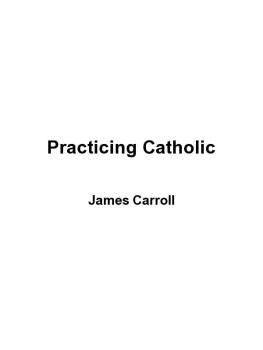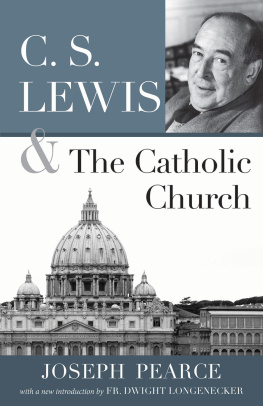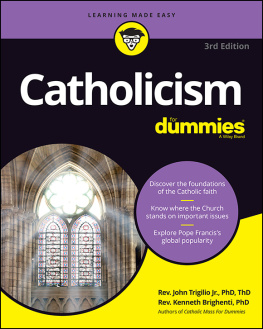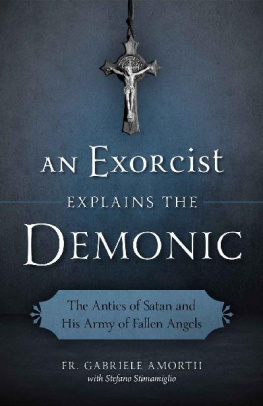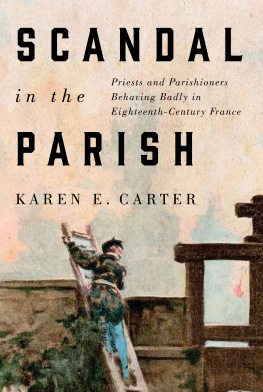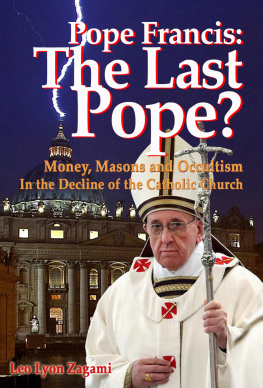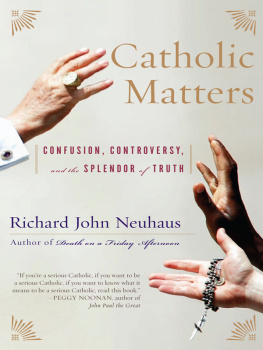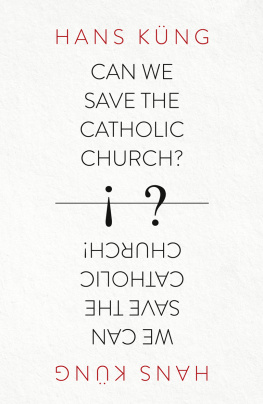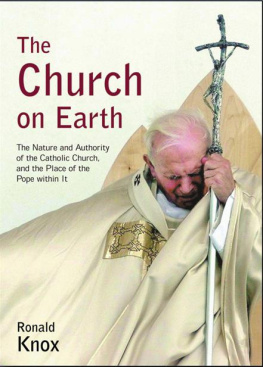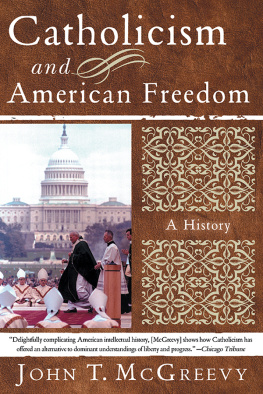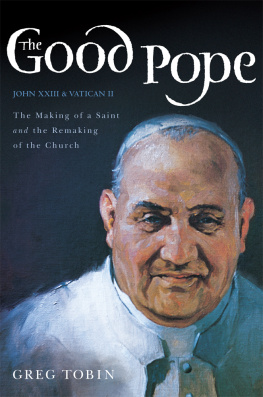First Mariner Books edition 2010
Copyright 2009 by James Carroll
ALL RIGHTS RESERVED
For information about permission to reproduce selections from
this book, write Permissions, Houghton Mifflin Harcourt
Publishing Company, 215 Park Avenue South,
New York, New York 10003.
www.hmhbooks.com
Library of Congress Cataloging-in-Publication Data
Carroll, James, date.
Practicing Catholic / James Carroll,
p. cm.
Includes bibliographical references and index.
ISBN 978-0-618-67018-5
1. Carroll, James, date. 2. CatholicsBiography. 3. Catholic
ChurchHistory20th century. 4. Catholic churchHistory
21st century. 5. Catholic ChurchDoctrines. I. Title.
BX 4705. C 327 A 3 2009
282.092dc22 [B] 2008037386
ISBN 978-0-547-33626-8 (pbk.)
Printed in the United States of America
Book design by Robert Overholtzer
DOC 10 9 8 7 6 5 4 3 2 1
The author is grateful for permission to quote from "Howl," from Collected
Poems, 19471980 by Allen Ginsberg. Copyright 1955 by Allen Ginsberg.
Reprinted by permission of HarperCollins Publishers.
FOR LEXA
Introduction
PRACTICING CATHOLIC
W HY AM I A CATHOLIC? There are a thousand ways to answer that question, and this book will take up many of them. By its end, there will be one answer. I will move through the three phases of my life as a Catholicfrom my youthful formation, in an immigrant family that magnificently achieved its assimilation; to my time as a seminarian and priest, which coincided with the unexpected hope of the Second Vatican Council; to life after the priesthood, a time when the limits of assimilation into the American consensus showed themselves, and the reforms of the council were repudiated, but when I discovered a far deeper meaning of the faith.
This book has the form of a personal and historical essay about the Catholic Church in my lifetimefrom the full flower of the faux-medieval Catholicism into which I was christened, through the heady arrival of an Irish-American subculture in the Kennedy era, the glorious witness of a humanist pope, the frightening dislocations of assassination and war, the crisis of authority over sexual morality, the political power-brokerage symbolized by a pope who helped end the Cold War, the ironic collapse of post-Vatican II Catholic identity after that "arrival," the stunning betrayal of the priestly sexual-abuse scandal, to the end of narrow denominationalism that sets Catholic Christians against Orthodox and evangelical Christians. After 9/11, fundamental assumptions of Islam came quickly into question, but so did the assumptions of every religion. Like millions of Catholics, my faith has been shaken by the events of our time. We have had to announce, "The Church is dead," while searching for a way to declare, "Long live the Church."
Leaving theology aside for the moment, this worldly rootedness has been a source of the Church's exceptional longevity as well as of its global reach. The diocesan structure of its organization, for examplewith bishops and cardinals exercising over local churches an authority derived from the transcendent power centeris a repetition of Rome's proconsul method of governance. The way the Church's finances are organized, with independent dioceses feeding support to that center; the way the Church's diplomacy is structured, with papal legates dispatched to world capitals; the way the cult of the leader is maintained, with the bishop of Rome regarded as the deity's vicarall of this echoes the methods of the imperium, a system that is otherwise long gone.
St. Peter's Basilica, after all, is an architectural duplication of the palace of the emperor; indeed, the word "basilica" derives from the basil wreath with which, in primordial Rome, the ruler was crowned. Meanwhile, Catholic doctrine is grounded in philosophical propositions that came into their own in the ancient world, which is why any revision of that doctrineis it even possible?would amount to an extraordinary intellectual and spiritual transformation. Down through the ages, the tension between the papacy and the councils of the Church, which across two thousand years were convened, on average, once each century, can be seen to have been analogous to the tension between Caesar and the Roman Senate, which ended tragically. Indeed, the Church has, if only accidentally, carried forward the internal conflict between republic and empire, a tension that, in the Church's case, while yet to be resolved, has become dramatic in the contemporary push-pull between the laity and lower clergy on one side, and the hierarchy on the other. For all of these reasons, Catholicism continues to be an object of fascination. And, admittedly, of repugnance.
Grave moral failings of the Church became evident in the era since my birth, and those historic failings were compounded by further mistakes in recent years. I reflect on this dark legacy, showing what it meant to me as I was repeatedly forced to confront it. But I aim less at judgmental criticism than at a loving act of remembrance, recalling Catholicsand myselfto what they have been at their best. A tradition centered on social justice, accommodation of immigrants, the work of peace, sacramental respect for creation, liturgical beauty, a global vision, and the consolations of faithall of this weighs as much in the scale of history as spiritual imperialism, scandal, and hypocrisy. One theme of Practicing Catholic is loss, but anotherthrough the embrace of changeis renewal. Catholic history is nothing but a saga of glory and tragedy, corruption and reform, false starts and new beginnings. In our time, this age-old pattern has been compressed and sped up, with an edge that cuts deeper than ever before.
I bring a Catholic sensibility to bear on this experience, but equally I bring an American sensibility, which is something else entirely. American Catholicism, which has been profoundly influenced by the nation's predominantly Protestant ethos, is a subject of its own here, with tension running in both directionsagainst the broader national culture, which is overtly secular but implicitly pietistic, and against European Catholicism, which in the past was established, hierarchical, and antimodern, but is at present in a state of near collapse. European Catholicism came to the United States and became something new, as it is today becoming something new in Africa and Asia. Third World religiosity may define the Catholic future, much as Europe defines its past. But American Catholicism stands decisively on its own ground, even if Rome has never fully accommodated that.
But whether they have abandoned the Church or remain with it, the religious identities of all of these people have undergone transformationthe kind of tectonic shifts in meaning and practice that this book will report. Many American Catholics and former Catholics will recognize their stories in this work, but so might all Americans whose religious identities have undergone transformation or obliteration in these tumultuous years.
I was born in 1943. Numerous global eruptions have upended religious and political assumptions in the decades since then. Europe, after two acts of continental self-destruction, yielded to the United States as the power center of the West. The United States, in turn, defined itself, theologically as well as politically, against communism abroad and at home. Basic flaws were laid bare in Western civilization (the Holocaust) and in America (continuing racism), with the recognition that hatred of the Other (whether Jews, blacks, or, say, Muslims) is still virulent. Women came to a new self-understanding, from the workforce jolt of World War II to the claustrophobia of the suburbs in the 1950s to the liberation of the 1960s (the birth control pill) and 1970s (
Next page
